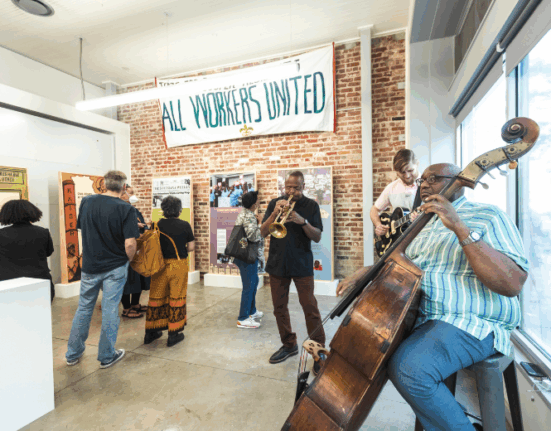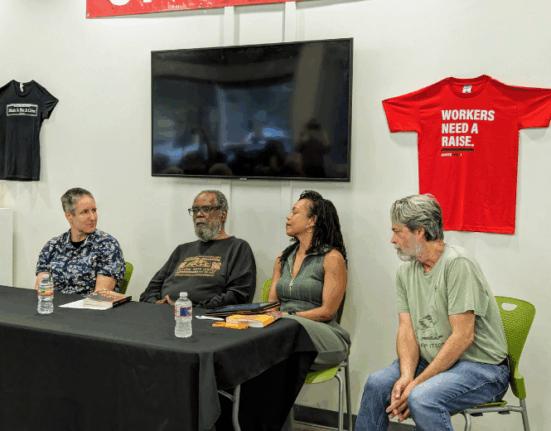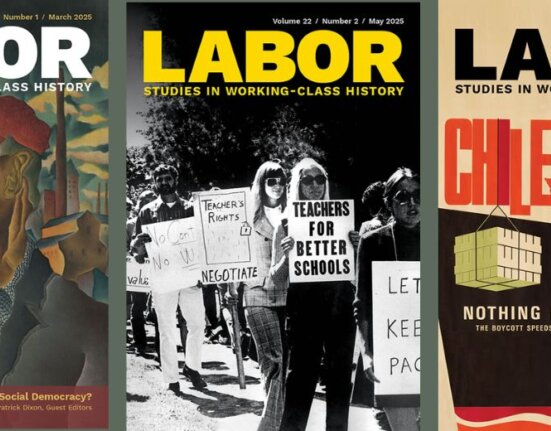It’s hard for most of us to recall any period in the last fifty years that we could call the “good times” for labor in the U.S. Membership density in American unions has been on a steady decline. The National Labor Relations Board has certified few new unions, and mergers have become common. Almost none of the major corporate enterprises founded over the last thirty years are unionized.
Legal reversals have followed these declines, and the beatings have been painful. Few were surprised that the Supreme Court ruled that unions could not require members of public sector unions to pay agency fees for bargaining and servicing, though the Janus ruling stung some unions badly. New York State and Pennsylvania already report 80,000 workers whose payments have ceased, depleting union coffers by tens of millions annually. The elimination of union security in Wisconsin has been cataclysmic. Texas will soon eliminate any payroll deductions for any public workers in any jurisdiction.
The cover of Harper’s Magazine’s Labor Day issue for September 2018 asks “Is This the End of American Unions?” The magazine doesn’t answer the question, but I will: “of course not!”
First, we shouldn’t assume that Janus dooms unions. Few other countries have representation fees for either the public sector workforce or the private sector workforce, yet they have labor unions. French unions don’t have such provisions. Nor do Australians. Unions in the United Kingdom lost union shop provisions for all workers under Margaret Thatcher. Very few unions around the world — from India to Argentina to Brazil to South Africa to the European Union — even have “exclusive” representation. Yet, all have unions and even labor movements of various shapes and sizes, strengths and weaknesses.
I asked organizers with the largest British unions (Unite, Unison, and the GMB) about how they responded when Thatcher ended their union dues regime. As they all explained, they decided that instead of fighting to reinstate the old rules, which the public saw as internal and esoteric, it would be smarter to have their members fight for more rights and benefits on the job. In fact, the GMB organizing director detailed a plan to move the whole union away from even payroll deductions to standing orders, or what we would call bank drafts, so that no one could stop the union.
Some American unions have also thrived by shifting the focus to building worker activism. Rand Wilson, now chief of staff of SEIU 888 and formerly a Teamsters strategist during the great United Parcel Service strike twenty years ago, suggested in Harpers article that the Janus decision may generate “a more activist base” in unions. That’s how SEIU Healthcare Illinois-Indiana-Missouri-Kansas (formerly United Labor Unions 880 and more recently SEIU 880) survived after losing the ability to collect agency fees in Illinois after the adverse Supreme Court decision in Harris v. Quinn. The impact was serious financially, but not substantive organizationally. Keith Kelleher, the founder, chief architect, head organizer, and recent president of the local union, always made sure that more than 50% of its rolls were full members, and the union beefed up the program even more in anticipation of the decision. In a recent Wall Street Journal article, Kelleher detailed the strategy and almost thumbed his nose at the efforts to derail the union. That success rested on decades of organizing through active engagement of members and leaders in every aspect of the union’s program. Is there any mystery why this is the largest single local union in the Midwest, despite only being founded less than 40 years ago?
Many hold up the Culinary Workers (UNITE HERE Local 226) as the strongest single local union in the country. When I visited some years ago, I was amazed at their full service, all-in approach to building the union. Yet Nevada is and always has been a right-to-work red state. Does anyone think the 60,000 private sector membership of this union reflects anything other than full engagement with workers?

Workers and their unions have risen phoenix-like over and over. In the last thirty years, more than a half-million informal workers in home health care and home child care have won coverage under union agreements in some of the largest organizing victories since the 30’s and 40’s. In the same period of decline, we have seen a historic victory at JP Stevens Mills, the grape boycott of the United Farm Workers, and the remarkable growth of all public sector unions. The living wage movement and the Fight for Fifteen have moved workers forward despite extreme opposition at the highest levels of government and amid rising inequality. Earlier this year, teachers in the deep red states of West Virginia, Oklahoma, Arizona, and North Carolina broke out of their classrooms and into the streets, inspiring millions over wages but also, importantly, over classroom conditions and school funding.
As these cases demonstrate, it isn’t the law that empowers workers and their unions. It’s workers themselves. When labor grows, the law tends to support it. When unions are in retreat, the law also weakens, because it can — sometimes faster than we might wish. Action follows reaction, back and forth, but the combustion and boiling heat of struggle by workers is indomitable. If unions are going to survive Janus intact, they must have a base of engaged members. What was passive, must become active. Unions that are unable – or unwilling – to activate their membership will either wither or merge. But the ones that persist will be stronger and more able to face the future.
We should also pay attention a lesson from the more than one-hundred “living wage” campaigns that ACORN and Local 100 United Labor Unions ran in coalition with other unions and community groups: we can win if we take the issue to the public rather than defining it solely in terms of worker versus boss, union versus company. That’s because winning isn’t just about a specific vote. In our first forays in Houston and Denver, back in 1995, we lost by 2 to 1 in both cities. But we won overwhelmingly in working-class black, brown, and white precincts, and we consolidated a strong base, building power even while losing. Our opposition sometimes helped. In Houston, the anti-campaign developed a patronizing “good idea, bad tactic” measure, conceding us the high ground. In Denver, a class-based effort financed by hotels and restaurants took the low ground, crystalizing the issue for the future. And we learned from these battles. When we set the living wage number lower to offset the job loss arguments, we won in New Orleans – and then in cities across the country.
We see similar elements in the recent struggles – and victories –by teachers, who were often ahead of their unions in engaging the public, just as the Chicago teachers did so effectively several years ago. In Missouri, unions won with an initiative to overturn legislation passed by the conservative Republican majority and signed by the Republican governor because they went directly to the people to argue for the merits and fairness of their proposition. Such battles can be risky, but the teachers dared to struggle, and their victory offers a lesson to us all about taking our issues to the people.
If our unions are to survive the legal and political attacks ahead of us, we have to build labor-community coalitions like this everywhere. This can’t be tactical and transactional. It has to be permanently strategic and transformative. The times will never be good for us, but our own work can bend the times in a better direction for our success. We cannot win on the battlefield laid out for us by corporations and employers. We have to create our own field where we can even the odds. That requires the full engagement of workers and the public in our fights.
This Labor Day all of us need to think about how to support workers moving forward and unions embracing the future. No sense in whining, when we could be winning. Our first order of business has to be to get to work and make the work matter to workers, their communities, and the larger world where the public is willing to support us — if we are just willing to take the risks and do the work to take our fights to them and ask for their support.
Wade Rathke






